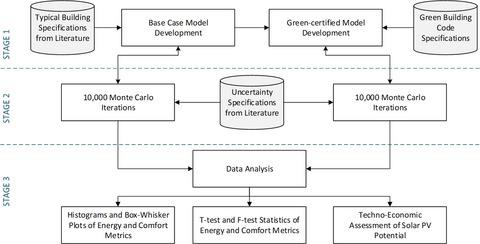当前位置:
X-MOL 学术
›
Energy Sci. Eng.
›
论文详情
Our official English website, www.x-mol.net, welcomes your
feedback! (Note: you will need to create a separate account there.)
A data‐driven modeling and analysis approach to test the resilience of green buildings to uncertainty in operation patterns
Energy Science & Engineering ( IF 3.5 ) Pub Date : 2020-09-25 , DOI: 10.1002/ese3.808 Noura Alkaabi 1 , Chung‐Suk Cho 2 , Ahmad Mayyas 1 , Elie Azar 1
Energy Science & Engineering ( IF 3.5 ) Pub Date : 2020-09-25 , DOI: 10.1002/ese3.808 Noura Alkaabi 1 , Chung‐Suk Cho 2 , Ahmad Mayyas 1 , Elie Azar 1
Affiliation

|
Green building design is a promising approach to reduce the energy intensity of the building sector. However, green buildings often show important discrepancies between their predicted and actual energy use levels, in part due to varying operation patterns that are difficult to predict during design. This paper presents a data‐driven modeling and analysis approach to test the resilience of green‐certified buildings to uncertainty in the operation of building systems. Using building energy modeling coupled with an extensive empirical Monte Carlo analysis scheme, the framework quantifies and compares the response of a building to uncertainty in key technical and operational features before and after the adoption of green building certification specifications. The framework is illustrated and validated through a case study of an archetype commercial building located in the extreme hot climate of Abu Dhabi, UAE. Results show that adopting the green building features of the local “Estidama” building code reduces energy demand by an average of 17%. More importantly, the variability in demand is reduced (P < .05), confirming the increase in building resilience to uncertainty in design and operation factors. Finally, the techno‐economic potential for solar photovoltaic (PV) adoption is also assessed, showing an estimated 16% reduction in capital costs.
中文翻译:

一种数据驱动的建模和分析方法,用于测试绿色建筑对运营模式不确定性的抵御能力
绿色建筑设计是降低建筑能耗的一种有前途的方法。但是,绿色建筑通常会在其预测的能耗水平与实际的能耗水平之间显示出重大差异,部分原因是在设计过程中难以预测的变化的运行模式。本文提出了一种数据驱动的建模和分析方法,以测试通过绿色认证的建筑物对建筑物系统运行中的不确定性的恢复力。该框架结合建筑节能模型和广泛的经验蒙特卡洛分析方案,在采用绿色建筑认证规范之前和之后,量化并比较了建筑物对关键技术和运营特征不确定性的响应。通过对位于阿联酋阿布扎比极端炎热气候中的原型商业建筑的案例研究,对框架进行了说明和验证。结果表明,采用当地“ Estidama”建筑法规的绿色建筑特征,平均可减少17%的能源需求。更重要的是,减少了需求的波动性(P <.05),证实了建筑物对设计和操作因素不确定性的适应能力增强。最后,还评估了采用太阳能光伏(PV)的技术经济潜力,估计可节省16%的资本成本。
更新日期:2020-09-25
中文翻译:

一种数据驱动的建模和分析方法,用于测试绿色建筑对运营模式不确定性的抵御能力
绿色建筑设计是降低建筑能耗的一种有前途的方法。但是,绿色建筑通常会在其预测的能耗水平与实际的能耗水平之间显示出重大差异,部分原因是在设计过程中难以预测的变化的运行模式。本文提出了一种数据驱动的建模和分析方法,以测试通过绿色认证的建筑物对建筑物系统运行中的不确定性的恢复力。该框架结合建筑节能模型和广泛的经验蒙特卡洛分析方案,在采用绿色建筑认证规范之前和之后,量化并比较了建筑物对关键技术和运营特征不确定性的响应。通过对位于阿联酋阿布扎比极端炎热气候中的原型商业建筑的案例研究,对框架进行了说明和验证。结果表明,采用当地“ Estidama”建筑法规的绿色建筑特征,平均可减少17%的能源需求。更重要的是,减少了需求的波动性(P <.05),证实了建筑物对设计和操作因素不确定性的适应能力增强。最后,还评估了采用太阳能光伏(PV)的技术经济潜力,估计可节省16%的资本成本。











































 京公网安备 11010802027423号
京公网安备 11010802027423号